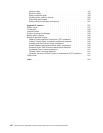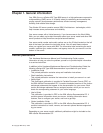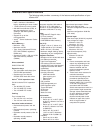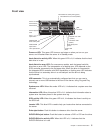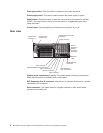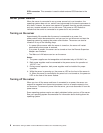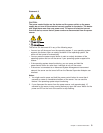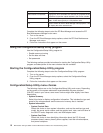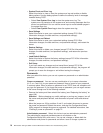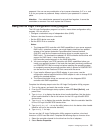
SCSI
connector:
This
connector
is
used
to
attach
external
SCSI
devices
to
the
server.
Server
power
features
When
the
server
is
connected
to
an
ac
power
source
but
is
not
turned
on,
the
operating
system
does
not
run,
and
all
core
logic
except
for
the
service
processor
is
shut
down;
however,
the
server
can
respond
to
requests
from
the
service
processor,
such
as
a
remote
request
to
turn
on
the
server.
The
power-on
LED
flashes
to
indicate
that
the
server
is
connected
to
ac
power
but
is
not
turned
on.
Turning
on
the
server
Approximately
20
seconds
after
the
server
is
connected
to
ac
power,
the
power-control
button
becomes
active,
and
you
can
turn
on
the
server
and
start
the
operating
system
by
pressing
the
power-control
button.
The
server
can
also
be
turned
on
in
any
of
the
following
ways:
v
If
a
power
failure
occurs
while
the
server
is
turned
on,
the
server
will
restart
automatically
when
power
is
restored.
v
If
ac
power
is
present,
the
server
can
be
turned
on
from
the
Remote
Supervisor
Adapter
user
interface.
v
The
Wake
on
LAN
feature
can
turn
on
the
server.
Notes:
1.
The
power
supplies
are
hot-swappable
and
redundant
only
at
200-240
V
ac.
2.
Both
power
supplies
must
be
connected
to
the
power
source
for
operation
at
100-127
V
ac.
3.
During
normal
operation,
both
power
supplies
must
be
installed
for
proper
operation.
4.
While
the
server
is
powering
up,
the
power-on
LED
on
the
front
of
the
server
is
lit.
When
the
server
is
connected
to
ac
power
but
is
not
turned
on,
the
power-on
LED
on
the
front
of
the
server
flashes.
Turning
off
the
server
When
you
turn
off
the
server
and
leave
it
connected
to
ac
power,
the
server
can
respond
to
requests
from
the
service
processor,
such
as
a
remote
request
to
turn
on
the
server.
To
remove
all
power
from
the
server,
you
must
disconnect
it
from
the
power
source.
Some
operating
systems
require
an
orderly
shutdown
before
you
turn
off
the
server.
See
your
operating-system
documentation
for
information
about
shutting
down
the
operating
system.
8
IBM
xSeries
450
Type
8688:
Hardware
Maintenance
Manual
and
Troubleshooting
Guide



